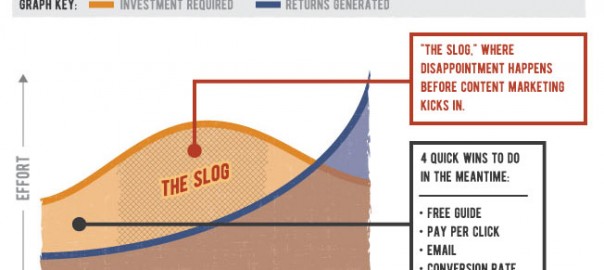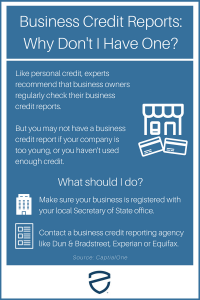With all the time and effort that goes into content marketing, the big question is: How do you get it to truly work? Columnist Quinn Whissen outlines four winning strategies.
 You’ve probably heard this before: “Content marketing is hard…Content marketing takes a long time.”
You’ve probably heard this before: “Content marketing is hard…Content marketing takes a long time.”
Sorry to say, I’m not here to tell you that’s wrong: It is hard, and it does take time.
But that doesn’t mean content marketing doesn’t work. It does. It just takes consistency, dedication and yes, time, before you see results.
In the meantime, however, you’re going to be sad. You might even get mad. Hell, you may even be full-on depressed. You might offer a cry up to the heavens: “Why is my content not worrrrrrrking!!!” And you hear no booming answers in return.
This, my friend, is called the content slog, as coined by Chris Bird of Vertical Measures (my employer) here. It’s that gap of disappointment where you’ve put in a good amount of time and effort into your content marketing strategy, and you aren’t seeing a return on your investment.
This principle rings true for other digital media, too, and is where this content slog idea originated. In particular, Moz’s Rand Fishkin and BuzzMaven Labs’ Scott Clark both talk about this idea in terms of SEO and its “lengthy period of diminishing returns” (per Fishkin).
We repurposed this idea to fit with our experience in content marketing and came up with this graph below. It shows the rate of investment required vs. returns generated, and where that slog occurs.

So what’s are content marketers to do when they are in an uphill battle between time and effort toward the top of Results Mountain? Follow the four strategies listed on the graph and outlined in the rest of this article to get quick wins that will jump-start your content marketing NOW.
Email Marketing
The oldest digital strategy in the playbook: email marketing. We’ve all been building lists since the dawn of the interwebs, so it makes sense this is where you should start while you’re waiting for your content marketing to kick in.
Take advantage of the list you already have, and start or amp up your email marketing strategies. You may need to prune your list or clean it up if it has been sitting there for a while, but these are people who have expressed interest in wanting to hear from you, so let them!
Here are some email types you can start creating right away:
- Monthly newsletter
- Product or service updates
- Point of view/opinion pieces
- Special promotions or discounts
- Repurposed content
Second, focus on your subscription strategies to continue to build your list. You’ll seriously thank yourself in the future when you’re ready to publish new content and already have fresh contacts to send it to.
I learned this lesson the hard way. After migrating the Vertical Measures website, we lost our prominent call-to-action to subscribe to the blog.
What we were left with was a tiny RSS button at the top of the site, mixed in with our other social icons. Hardly an appealing or even apparent way to receive our weekly blog updates.
So finally, 10 months after our migration and adding a sidebar subscription button that didn’t do anything, we got ourselves in gear to design and develop a subscription form that no one could miss:

The results have been astounding and should be big wake-up call for anyone in the throes of content slog agony. We saw a 581 percent increase in the number of subscriptions in the the first 2.5 months the call-to-action was live compared with the previous 10 months after our site migration. Let me repeat: 581 percent increase in two months compared with the previous 10 months.
If that’s not a quick win, I don’t know what is.
To wrap this up, focus on three things with your email marketing:
- Take advantage of the list you already have.
- Create a subscription strategy NOW.
- Bonus! Test your emails to get the most out of them with a few simple hacks outlined in my previous article.
Pay Per Click
PPC isn’t always uttered in the same breath as content marketing, but they can work well together. Whereas much of content development is targeted at organic traffic and rankings, PPC is a direct line to drawing in traffic, leads and possibly more business.
Plus, it’s predictable. You know how much you want to spend, where you want to spend it, and exactly what results you need for a positive ROI.
Don’t shy away from PPC; embrace it during the slog! Take advantage of AdWords if you have some keywords you can competitively bid on, and even more importantly, start to increase your budget for content promotion on social networks.
I’ve seen companies get major returns through Facebook Ads or Sponsored Tweets, so get your feet wet with optimizing your ads and audiences while you’re churning out great content that will soon be published.
Conversion Rate Optimization
Conversion Rate Optimization, otherwise known as CRO, is a form of testing and tweaking until you see the results you want. CRO can often go hand-in-hand with your active PPC campaigns, as mentioned above, where you are optimizing your landing pages for the most completions.
The way I like to look at it comes from Vertical Measures’ Zach Etten, who is a PPC whiz and overall testing guru. The way he explains it is this, as illustrated by some hard numbers:
- This is your current situation. You want to increase your sales twofold.

- You think you need to double sales to double your traffic. But doubling traffic doesn’t happen overnight. In fact, it could take a year’s worth of hard work to build up content to point to your landing page, or a large budget for your PPC ads.

- Solution: Instead of doubling traffic, double your conversion rate! This produces the same outcome, but it’s something that takes a lot less work, with a quicker turnaround.

CRO is the simplest hack you can start doing now, while you’re working on your content strategies. Test everything — your headline, your form placement, how many fields you require, colors, font size, everything. It all affects how easily someone is willing to give up their information on a landing page.
For example, the team at Vertical Measures did some PPC landing page optimization for a law firm client of ours. The before and after may not look like a drastic overhaul visually, but the results say something different.
The client saw a 77 percent increase in conversions, and what’s even more staggering is that their cost per lead decreased by 32 percent. Do CRO. It matters.

Hub and Spoke Content
If you haven’t jumped on the hub-and-spoke train, welcome aboard. This is probably my favorite type of content model for a few reasons:
- Hubs drive traffic.
- Hubs drive leads.
- Hubs are great pieces of evergreen content.
This is especially true when you’re new to content marketing and working on many projects in the background, but you have yet to publish much content. If you shift your mindset to creating a hub right off the bat, you’ll see results quickly.
So what’s a hub? A hub is a larger piece of content that usually hides behind a gated form. It requires the interested visitor to provide some information to obtain that piece of content — maybe it’s a PDF download or multiple files. The visitor shows intent and interest, and you get some of his or her personal information in exchange.
And what’s a spoke? Spokes are pieces of content that point back to your hub. Oftentimes, they can be repurposed sections of your hub content or something related to the topic you cover. Spokes always link back to the hub or integrate a strong CTA.
Spokes can take the form of blog posts, press releases, videos, graphics, emails, on and on. Spokes have one singular goal: to point the content consumers back to your hub so they will then convert.
As an example, here’s an illustration of how a hub-and-spoke model can work. This is for the Google Penalty Recovery Kit that Vertical Measures put together to assist people in the midst of a website penalty.
The hub itself contained a free guide with an overview of penalty recovery, an example Disavow file to use in Google and a spreadsheet to help with backlink analysis. The spokes were varied and scheduled out even before we created the hub, all with the goal to push people back to the download.

The hub is where all your other quick wins come together and spark results. You create the hub, announce it to your list with email marketing, run some PPC ads to drive traffic to your download, and of course, test and tweak your landing page with CRO for best results.
If you can’t get to the spokes yet, just focus on creating them when you can, and focus on driving people toward your hub.
Conclusion
I know you want your content marketing to work, and so do I. So utilize these four strategies (and any more that you can come up with) to get a jump-start on driving real content marketing results.
If convincing your boss to even start content marketing was half the battle, then producing results sooner rather than later is vital to the longevity of your content marketing program.
Some opinions expressed in this article may be those of a guest author and not necessarily Marketing Land. Staff authors are listed here.





